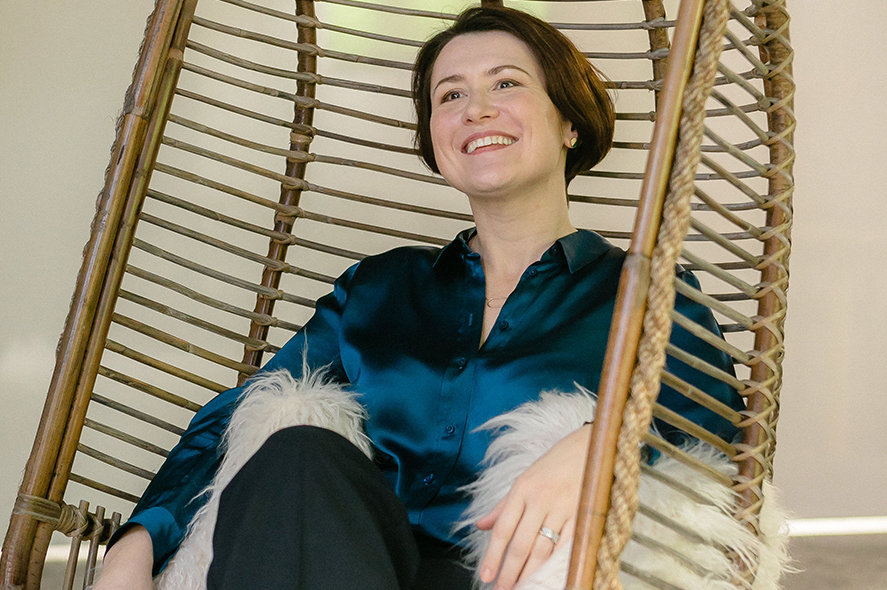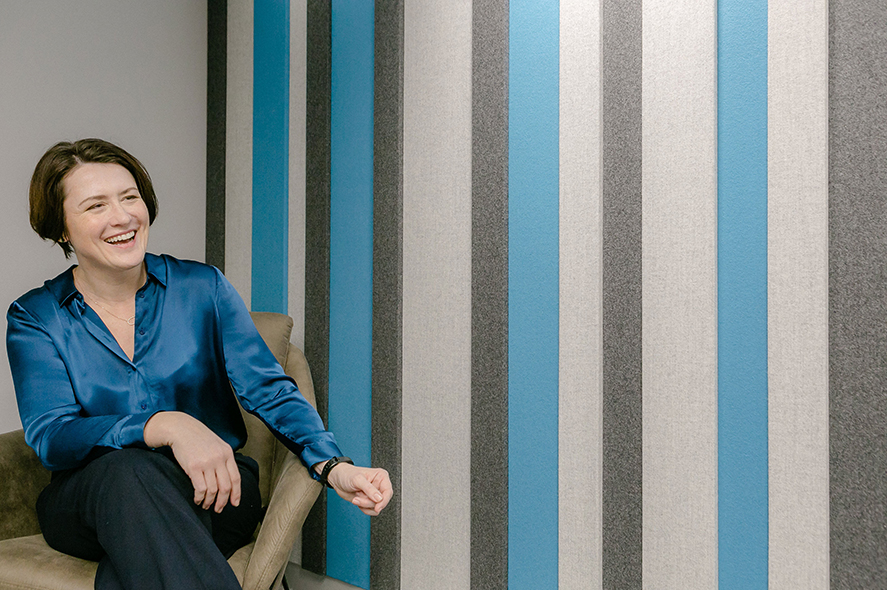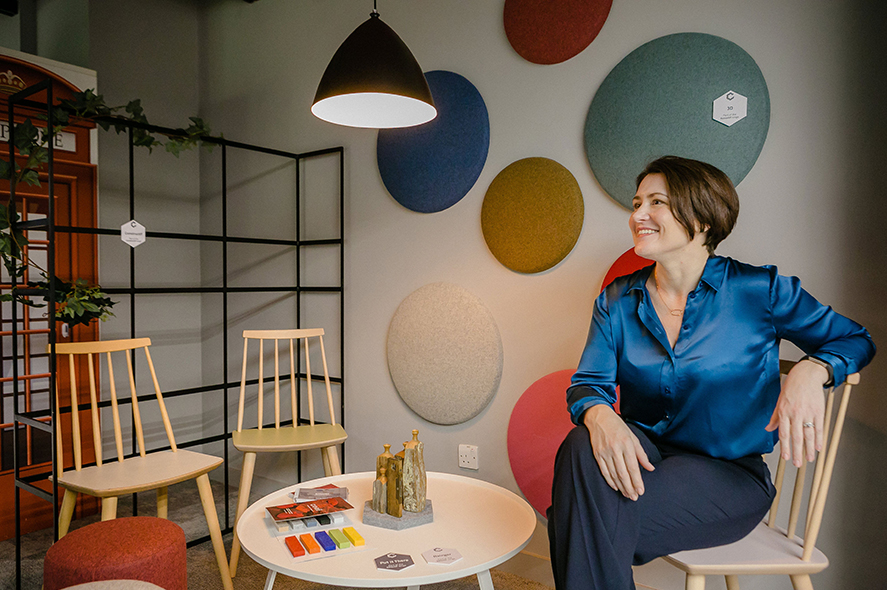|
Georgia Elliott-Smith studied Environmental Engineering at the University of Portsmouth and has been improving environmental best practices ever since. As well as being a WELL Building Standard Accredited professional and Fitwel Ambassador, Georgia spends her days providing expert advice and supporting organisations in the implementation of well-being strategies.
We caught up with Georgia, a current director at the Fourfront Group, to explore how sustainability has shaped her career and how - and why - she's mentoring the next generation of talent entering our industry. Creatif: To begin, could you tell us about some of the first projects you worked on whilst studying for your degree? GE-S: I'd applied to various engineering companies including Thames Water and London Underground. However, it was Bovis Construction that took a real interest in me and offered me a great sponsorship package whilst at University. During my time studying, I worked as an on-site Assistant Project Manager and Environmental Manager. After graduating, I became the company’s first [permanent] Environment Manager. Being a sponsored undergraduate offered some incredible experiences. Bovis and their suppliers sponsored me on an expedition to Antarctica and I became a UNESCO Special Junior Envoy for Youth and the Environment – this enabled me to travel around the country giving lectures to school children and encourage them to go in to construction.
Creatif: How did you influence particular projects? GE-S: Being the first Environmental Manager, I developed the company’s environmental management system, carried out supply chain monitoring and trained hundreds of my colleagues and our suppliers across Europe. I worked to reduce waste, increase recycling, avoid pollution and minimise energy consumption. It was an exciting challenge which I thoroughly embraced. Creatif: Sustainability and greener buildings are hot topics right now. How do you make a significant impact with the clients you work with? GE-S: I’m passionate about helping people become more environmentally and socially responsible, both on projects and within organisations. I work with clients, design teams and suppliers to ensure we’re approaching projects with fresh eyes and not just replicating decades-old familiar patterns of work. Education and collaboration are key: It’s no use pushing all the environmental responsibility down the procurement chain where many small suppliers are expected to deliver all our environmental improvements. Larger clients and contractors have a responsibility to partner and support suppliers to be greener. Creatif: Do you face resistance to environmentally friendly alternatives based on the cost – if so, how do you combat these challenges? GE-S: The term ‘sustainability’ is often used inappropriately and seems to now be synonymous with something being niche, difficult and expensive. But think about the meaning of the word – if something is expensive and damaging to the business, it is fundamentally not sustainable. Done right, the application of sustainable measures benefits business in the long term. Any additional costs must be offset by corresponding benefits that allow businesses, communities and the environment to flourish. For me, cutting out waste in all its forms is fundamental. Providing an environmentally- and socially-responsive workspace will create positives such as brand loyalty, embraced values and a sense of pride when working for a company that’s demonstrating a clear commitment to doing as little damage to the environment as possible.
We all have a responsibility; I focus on explaining that there are long-term benefits gained by using green alternatives. Creatif: How do you educate people on the importance of environmentally considerate buildings? GE-S: Empowering people to feel like they can make a real difference, every single day, is the best way I believe I can get the message across. Opening up a debate, leading by example, using evidence such as case studies that not only includes scientific research but look beautiful too. I think that people often feel overwhelmed by the challenges our planet is facing such as the amount of plastic in our oceans or the effects of climate change, which is understandable. If we encourage individuals to look at better ways of working with greener resources available, then we can inspire more and more people to do the same. |
There was a recent example of personal impact, where a van driver for a well-known supermarket brand was filmed by a member of the public getting out and picking up rubbish that had been littered at the side of the road. He didn’t have to, but he chose to, and this kind of behaviour should be recognised and rewarded in my book. Creatif: It has been confirmed that there is a significant shortage of STEM skills in the UK. How do you feel about this, considering your work in the industry? GE-S: I’m fortunate to have founded the YEP (Young Entrepreneurs in Property) in 2002, which is a networking and career development group for entrepreneurial young professionals in the property and construction industry. A core component of this involved securing corporate sponsorship and inviting speakers that would inspire and motivate young people. It was my mission to create a place where like-minded individuals could learn and develop their skills. They were also able to meet contemporaries from a myriad of other facets in the property and construction industry, allowing them to see the breadth of opportunity and exciting career paths this industry can offer. Many of those original YEP members are still friends and have gone on to have very interesting and successful careers. Fourfront Group also has a very active NextGen group, a young professionals business network designed to accelerate skills development, connect young people within Fourfront, and channel their expertise back into the business. The programme is open to those aged 30 or under working within Fourfront, Area, Cube Interior Solutions, 360 Workplace or Sketch Studios. I am also a passionate advocate for mentoring – it’s so important that those of us who have been in our careers for some time give back our time and energy to assist others. Creatif: As the Head of 360 Wellbeing, how does your experience in environmental engineering work alongside your approach to well-being in the workplace? GE-S: It’s all connected. The fact that we spend 93% of our time indoors, either at work, in shops, at home or in transit is quite alarming. Even our social contact is being limited due to the advances of technology, so well-being is simply looking at how we can provide the best environment for humans to work in that has a positive effect on their mental, social and physical health.
I work with the design team to ensure that internal environments work synergistically with our bodies. We need fresh air, access to daylight, outside views and natural elements such as wood and organic fabrics. There is so much evidence confirming the link between human health and nature, so I encourage biophilic design and the benefits plants can provide on all of our senses. We know vast expanses of foliage have acoustic benefits as well as improving air quality and being attractive to look at. Humans are negatively impacting the environment, so WELL certified buildings are working towards carefully considering the natural environment and treating external elements with respect. It’s fascinating how much scientific research now confirms the extent to which our environment impacts on our well-being. Creatif: What elements of biomimicry do you utilise when designing a WELL building? GE-S: Non-rhythmic movement(s), such as daylight filtering through the trees, ripples on water or clouds across the sky, the calming fluidity of fish gently moving through a body of water, or varying spaces, shadows and light can all produce a comfortable and almost meditative state. This has been known for years and applied in sensory rooms for babies and those with developmental challenges. When we create static working environments, we are working against our fundamental mechanics which leads to huge health problems. The air purifying properties of indoor plants are astonishing – they can remove toxic substances from the air and increase oxygen. But did you also know that looking at fake plants, images of nature and natural textures and patterns can also reduce stress and create a calming environment? I find this fascinating and a lot of research is going on around the world to better understand and apply this phenomenon. Creatif: What’s been your favourite project you’ve been involved with? GE-S: About 15 years ago, I was the original Sustainability Manager on the development of New Street Square in Central London for LandSec – a development of around a million square feet. It was incredibly challenging and exciting to be involved in this fantastic scheme, designed by Bennetts Associates, which is still robust, energy efficient and it satisfies its users. I’m fortunate to still be close to the project. Sketch recently completed work on Deloitte’s recent refurbishment of 1 New Street Square, which is the first project in the world to achieve both BREEAM Outstanding and WELL Gold certification, is the largest WELL certified interiors project, and has the highest ever BREEAM fit-out score - an amazing achievement! |



